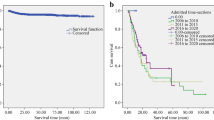Abstract
Purpose
The mortality rate of patients with retinoblastoma still varies in developing countries, and data for Asia and Taiwan are relatively scarce. In this retrospective study, we aimed to describe the survival characteristics and prognostic factors of 54 retinoblastoma cases diagnosed at the Taipei Veterans General Hospital between 1982 and 2004.
Methods
From medical records, we retrospectively analyzed the data of 54 consecutive children diagnosed in our hospital between 1982 and 2004 as having retinoblastoma. Data on sex, laterality, age at diagnosis, presenting signs, family history, duration of symptoms, lag time for treatment, spread of tumor, treatment mode, and survival time were collected.
Results
Seventy-five percent of the cases were unilateral and 25% of the cases were bilateral. The mean patient age at the time of diagnosis was 26.3 months. The mean duration of symptoms was 2.96 months. After diagnosis, the mean lag time before treatment was 2.59 months. The most common presenting signs were leukocoria (71.4%), red, painful, or tearing eye (18.4%), strabismus (14.3%), and blurred vision (14.3%). Only 3 of 52 cases (5.8%) were familial. The most common sites of extraocular invasion included the central nervous system (seven cases) and the orbit (seven cases). In 13.7% of the cases, parents had refused the treatment suggested by the doctors. None of the patients developed a secondary neoplasm. The 5-year overall survival rate was 80.9% (unilateral, 88.1%; bilateral, 64.3%). The survival rate of patients with an interval between onset and treatment of <5 months was 90.9%, and that for an interval of >5 months was 60.9%. The survival rate of those with a lag time of <2.5 months was 90.0%, and that of those with one of >2.5 months was 31.3%. The survival rate of patients with intraocular and extraocular disease was 96.9% and 39.2%, respectively. Extraocular disease was an independent factor indicating a poor prognosis, determined by multivariate analysis.
Conclusions
The mortality rate of patients with retinoblastoma is higher in Taiwan than in developed countries. The proportion of patients' parents refusing or delaying treatment in Taiwan is high. The factors for a poor prognosis were an interval between onset and treatment of >5 months, a lag time before treatment of >2.5 months, and extraocular disease. The duration of symptoms was not a prognostic factor. The only independent factor indicating a poor prognosis was extraocular disease. Jpn J Ophthalmol 2006;50:242–249 © Japanese Ophthalmological Society 2006
Similar content being viewed by others
References
G Gatta R Capocaccia MP Coleman LA Gloeckler Ries F Berrino (2002) ArticleTitleChildhood cancer survival in Europe and the United States Cancer 95 1767–1772 Occurrence Handle12365026 Occurrence Handle10.1002/cncr.10833
I Gunalp K Gunduz Y Arslan (1996) ArticleTitleRetinoblastoma in Turkey—treatment and prognosis Jpn J Ophthalmol 40 95–102 Occurrence Handle8739506 Occurrence Handle1:STN:280:BymA38%2FotFE%3D
T Mouratova (2003) ArticleTitleRetinoblastoma in Uzbekistan Bull Soc Belge Ophtalmol 289 63–69 Occurrence Handle14619631
F Cerecedo Diaz E Lopez Aguilar et al. (2003) ArticleTitleSurvival and clinical features of retinoblastoma Ann Pediatr 58 3–9 Occurrence Handle1:STN:280:DC%2BD3s7hsV2ntw%3D%3D Occurrence Handle10.1157/13042236
InstitutionalAuthorNameThe Committee for the National Registry of Retinoblastoma (1992) ArticleTitleSurvival rate and risk factors for patients with retinoblastoma in Japan Jpn J Ophthalmol 36 121–131
SM Saw N Tan SB Lee KG Au Eong KS Chia (2000) ArticleTitleIncidence and survival characteristics of retinoblastoma in Singapore from 1968–1995 J Pediatr Ophthalmol Strabismus 37 87–93 Occurrence Handle10779266 Occurrence Handle1:STN:280:DC%2BD3c3jvFGlug%3D%3D
DO Sukumaran (1991) ArticleTitleRetinoblastoma—a 20 year review from the University Hospital Kuala Lumpur Med J Malaysia 46 129–135 Occurrence Handle1839416 Occurrence Handle1:STN:280:By2B3cvgsFA%3D
E Matsunaga H Ogyu (1976) ArticleTitleRetinoblastoma in Japan: follow-up survey of sporadic cases Jpn J Ophthalmol 20 266–282
DH Abramson RB Notterman RM Ellsworth FD Kitchin (1983) ArticleTitleRetinoblastoma treated in infants in the first six months of life Arch Ophthalmol 101 1362–1366 Occurrence Handle6615299 Occurrence Handle1:STN:280:BiyA3cfhtlA%3D
GY Mario (1978) ArticleTitleRetinoblastoma: analysis of 235 cases J Radiat Oncol Biol Phys 4 359–365
SS Donaldson PR Egbert I Newshan et al. (2002) Retinoblastoma PA Pizzo DG Poplack (Eds) Principles and practice of pediatric oncology Lippincott-Raven Philadelphia 825–846
F Doz S Neuenschwander D Plantaz et al. (1995) ArticleTitleEtoposide and carboplatin in extraocular retinoblastoma: a study by the Societé Francaise d'Oncologie Pediatrique J Clin Oncol 13 902–909 Occurrence Handle7707117 Occurrence Handle1:STN:280:ByqB383jtFM%3D
RF Jubran EE Anat A Butturini A Linn Murphree JG Villablance (2004) ArticleTitleApproaches to treatment for extraocular retinoblastoma—Children's Hospital Los Angeles experience J Pediatr Hematol Oncol 26 31–34 Occurrence Handle14707710 Occurrence Handle10.1097/00043426-200401000-00011
CB Pratt DB Crom C Howarth (1985) ArticleTitleThe use of chemotherapy for extraocular retinoblastoma Med Pediatr Oncol 13 330–333 Occurrence Handle4046972 Occurrence Handle1:STN:280:BimD3MzotVQ%3D
G Chantada A Fandino L Urrutia Manzitti E Schvartzman (1999) ArticleTitleLate diagnosis of retinoblastoma in a developing country Arch Dis Child 80 171–174 Occurrence Handle10325735 Occurrence Handle1:STN:280:DyaK1M3lslGrtw%3D%3D
CM Erwenne EL Franco (1989) ArticleTitleAge and lateness of referral as determinants of extra-ocular retinoblastoma Ophthalmic Paediatr Genet 10 179–184 Occurrence Handle2587030 Occurrence Handle1:STN:280:By%2BD28jlt1M%3D
V Saha S Love T Eden P Micallef-Eynaud G MacKinlay (1993) ArticleTitleDeterminants of symptom interval in childhood cancer Arch Dis Child 68 771–774 Occurrence Handle8333770 Occurrence Handle1:STN:280:ByyA38ngtlU%3D Occurrence Handle10.1136/adc.68.6.771
Author information
Authors and Affiliations
Corresponding author
About this article
Cite this article
Chang, CY., Chiou, TJ., Hwang, B. et al. Retinoblastoma in Taiwan: Survival Rate and Prognostic Factors. Jpn J Ophthalmol 50, 242–249 (2006). https://doi.org/10.1007/s10384-005-0320-y
Received:
Accepted:
Issue Date:
DOI: https://doi.org/10.1007/s10384-005-0320-y




